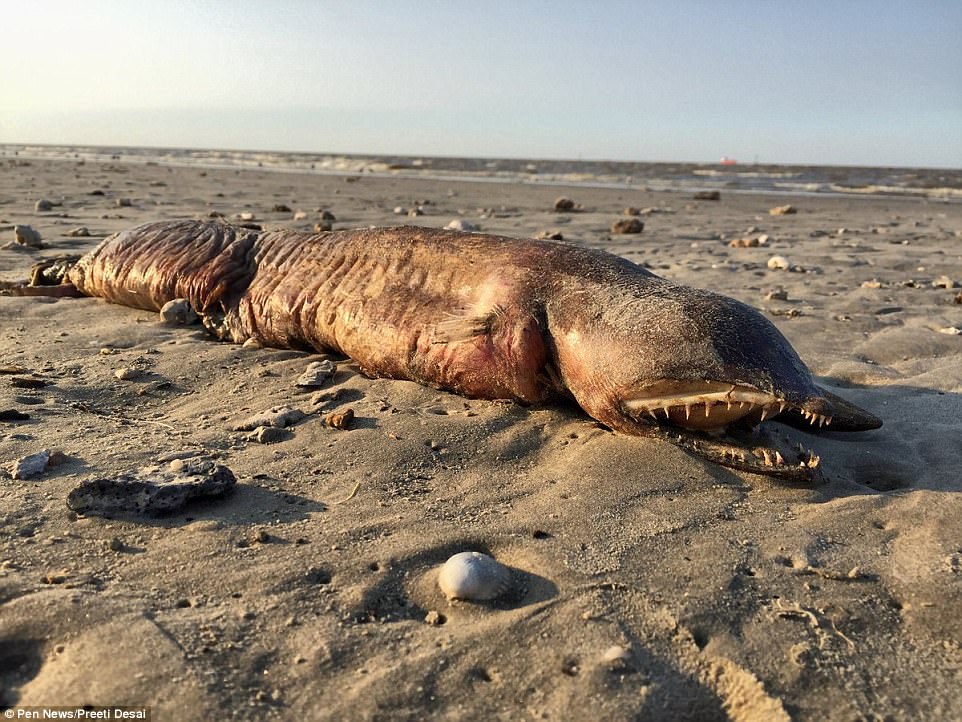Mysterious eyeless sea creature with razor-sharp teeth and a tail washes up on a Texas beach after Hurricane Harvey
Thu 14 Sep 2017, 01:17:37

Hurricane Harvey didn't just displace people, it displaced sea creatures too.
Last week, Preeti Desai of the National Audobon Society took to Twitter for help identifying a mysterious creature she found washed onto a Texas City beach after Hurricane Harvey.
The apparently eyeless dead animal sported a mouth of razor-sharp teeth and a large cylinder-shaped body.
'On first glance it looked like something from the deep sea to me,' Desai said. 'My initial thought was it might be a sea lamprey but when I got close I realized there was no way that was what it was, particularly based on the mouth.
'We squished it around a bit, and even turned it over but couldn't come up with any other ideas.'
So Desai posted the pictures on Twitter and asked biologists for help.
'This is the kind of thing that's perfect for Twitter - there are so many scientists and researchers on the platform and they're very willing to jump in and figure out things like this,' she said.
The biologists who responded to Desai's post believed that the sea monster was some type of eel, but they had a hard time pegging
just what kind.
'I mentally smacked my forehead, because once that was suggested I could absolutely see the eel shape,' Desai said.
The most popular opinion was that the animal was a fangtooth snake-eel, also known as the tusky eel, which is native to the Gulf of Mexico.
Tusky eels live in waters about 30 to 90 meters deep and spend most of their time hidden away, but do occasionally venture into shallows.
Tusky eels also have eyes, but they are small and could have decomposed by the time Desai found the creature's body.
Dr. Kenneth Tighe of the Smithsonian National Museum of Natural History believes the dead creature is a tusky eel, but he said that it could also be in another eel family - either the garden or conger eels.
However, it's large teeth rule out most species in those two families.
'It might be Bathyuroconger vicinus or Xenomystax congroides,' he said. 'All three of these species occur off Texas and have large fang-like teeth. Too bad you can't clearly see the tip of the tail. That would differentiate between the ophichthid and the congrids.'
Last week, Preeti Desai of the National Audobon Society took to Twitter for help identifying a mysterious creature she found washed onto a Texas City beach after Hurricane Harvey.
The apparently eyeless dead animal sported a mouth of razor-sharp teeth and a large cylinder-shaped body.
'On first glance it looked like something from the deep sea to me,' Desai said. 'My initial thought was it might be a sea lamprey but when I got close I realized there was no way that was what it was, particularly based on the mouth.
'We squished it around a bit, and even turned it over but couldn't come up with any other ideas.'
So Desai posted the pictures on Twitter and asked biologists for help.
'This is the kind of thing that's perfect for Twitter - there are so many scientists and researchers on the platform and they're very willing to jump in and figure out things like this,' she said.
The biologists who responded to Desai's post believed that the sea monster was some type of eel, but they had a hard time pegging
just what kind.
'I mentally smacked my forehead, because once that was suggested I could absolutely see the eel shape,' Desai said.
The most popular opinion was that the animal was a fangtooth snake-eel, also known as the tusky eel, which is native to the Gulf of Mexico.
Tusky eels live in waters about 30 to 90 meters deep and spend most of their time hidden away, but do occasionally venture into shallows.
Tusky eels also have eyes, but they are small and could have decomposed by the time Desai found the creature's body.
Dr. Kenneth Tighe of the Smithsonian National Museum of Natural History believes the dead creature is a tusky eel, but he said that it could also be in another eel family - either the garden or conger eels.
However, it's large teeth rule out most species in those two families.
'It might be Bathyuroconger vicinus or Xenomystax congroides,' he said. 'All three of these species occur off Texas and have large fang-like teeth. Too bad you can't clearly see the tip of the tail. That would differentiate between the ophichthid and the congrids.'
No Comments For This Post, Be first to write a Comment.
Most viewed from International
Most viewed from World
AIMIM News
Asaduddin Owaisi files nomination papers on Friday
Apr 20, 2024
Owaisi Begins Election Campaign in Hyderabad
Apr 13, 2024
Bring back Indian workers in Israel: Owaisi
Apr 13, 2024
Latest Urdu News
Most Viewed
May 26, 2020
Do you think Ruturaj Gaikwad would be a good captain for Chennai Super Kings?
Latest Videos View All
Like Us
Home
About Us
Advertise With Us
All Polls
Epaper Archives
Privacy Policy
Contact Us
Download Etemaad App
© 2024 Etemaad Daily News, All Rights Reserved.

.jpg)
.jpg)
.jpg)
.jpg)
.jpg)
.jpg)
.jpg)

.jpg)
.jpg)
.jpg)

.jpg)
.jpg)
.jpg)
.jpg)
.jpg)
.jpg)
.jpg)
.jpg)
.jpg)
.jpg)
.jpg)
.jpg)
















